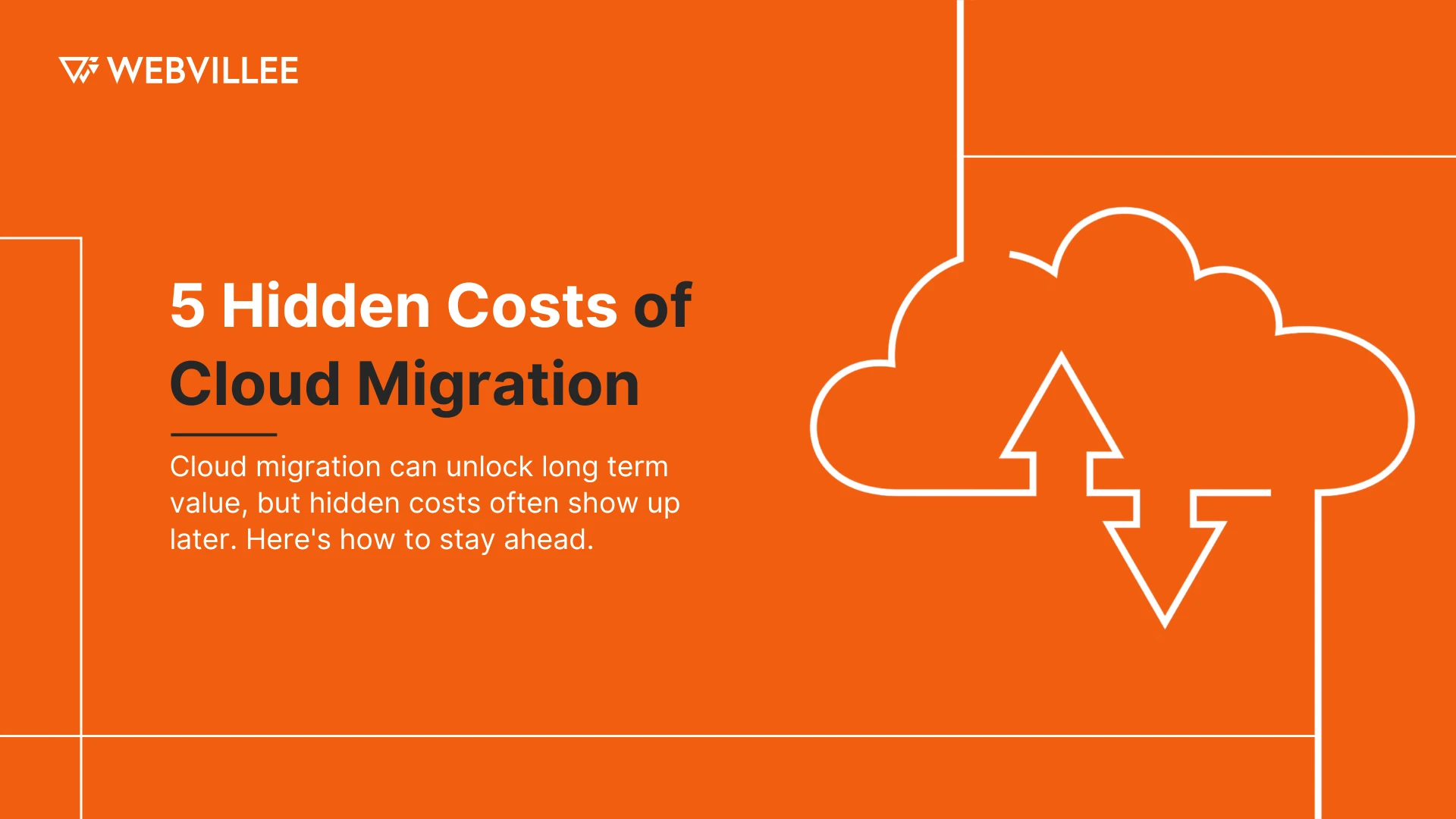Migrating to the cloud offers flexibility, speed, and long-term savings, but the hidden costs of cloud migration often catch businesses off guard. What starts as a plan to modernize infrastructure can quickly snowball into unexpected expenses if not approached with clarity.
Many companies focus on the obvious costs such as subscriptions, storage, and migration tools. But beneath the surface lie expenses that impact both budgets and timelines. These include overlooked areas like downtime, integration complexity, and ongoing optimization.
Before making the move, it is critical to:
- Evaluate your data transfer volume and speed
- Understand how legacy tools will interact with new cloud environments
- Plan for continuous performance tuning post-migration
Most of these costs are not technical failures. They come from incomplete planning. That is why choosing the right strategy and partner matters.
At Webvillee, we help businesses navigate cloud migration smartly with structured planning and tailored cloud solutions that reduce risk and waste.
In the sections ahead, we’ll break down five hidden cost areas and how to avoid them in 2025.
1. Underestimated Data Transfer Expenses
One of the most overlooked hidden costs of cloud migration is how much it actually costs to move your data. While uploading to the cloud is often free or low-cost, downloading or transferring data across regions can be surprisingly expensive.
Many businesses only factor in the size of their initial migration. But there are other factors that drive up costs:
- Ongoing data syncing between environments
- Accessing cloud backups across regions
- Frequent downloads for analytics or reporting
- API usage that triggers additional data movement
These expenses add up over time and can impact your cloud budget significantly.
To avoid this, plan ahead:
- Estimate both upload and download volumes early
- Choose providers with clearer, predictable bandwidth pricing
- Compress data where possible before transfer
- Set access policies that reduce unnecessary downloads
With better forecasting and usage controls, you can prevent data transfer from becoming a silent budget drain.

2. Downtime and Business Disruption
One of the hidden costs of cloud migration that businesses often underestimate is downtime. Even short periods of disruption can lead to productivity loss, missed deadlines, and customer dissatisfaction.
The most common reasons include:
- Poorly timed migration schedules
- Unfamiliar infrastructure causing delays
- Incomplete testing before switching systems
- Lack of fallback plans during cutover
If teams cannot access critical tools or data, daily operations quickly stall. This not only affects internal teams but can also impact your customers’ experience.
To reduce downtime and disruption:
- Plan migrations outside of business-critical hours
- Use a phased rollout instead of a full switch
- Test in a sandbox environment before going live
- Inform all teams in advance and assign support roles
Smooth transitions are possible with the right preparation. Focus on minimizing surprises to keep your operations stable during the move.
3. Integration Complexities with Legacy Systems
Integrating legacy software with modern cloud platforms often sounds simple, but rarely is. One of the overlooked challenges during cloud migration is the time and cost it takes to sync your existing systems with new cloud infrastructure.
Legacy tools may have:
- Outdated architectures
- Limited API support
- Hardcoded workflows that resist change
Trying to force a connection between old and new systems can lead to:
- Custom development costs
- Frequent maintenance to fix broken integrations
- Slower performance or unexpected data issues
To reduce these costs, plan for integration early:
- Audit legacy systems to assess compatibility
- Use middleware or integration platforms where possible
- Redesign workflows that rely heavily on outdated logic
- Build modular connections that can evolve with your tech stack
Smart architecture planning saves time and frustration later. Seamless integration should be part of your migration roadmap, not an afterthought.

4. Security and Compliance Gaps
One of the most expensive hidden costs of cloud migration is dealing with security and compliance issues after the move. Many teams assume cloud platforms handle it all, only to discover gaps when it is too late.
Common risks include:
- Misconfigured access controls
- Unencrypted sensitive data
- Missing audit trails
These gaps can result in:
- Regulatory penalties (especially under GDPR, HIPAA, or ISO standards)
- Reputational damage
- Customer trust issues
To avoid these pitfalls, security needs to be part of the migration plan from day one:
- Conduct a pre-migration compliance review
- Use built-in cloud tools for identity management, encryption, and monitoring
- Schedule regular third-party audits to identify risks early
- Define clear policies for data access and usage across teams
Fixing issues post-launch is always more expensive. A proactive approach to security saves costs and builds confidence.
5. Underestimated Post-Migration Optimization
Many businesses assume the heavy lifting ends once the cloud migration is complete. In reality, the work has just begun. One of the most common hidden costs of cloud migration is the ongoing need for tuning, scaling, and system optimization.
Post-migration costs often include:
- Performance tuning to maintain speed and uptime
- Auto-scaling and load balancing to support usage spikes
- Governance tools to manage access, cost controls, and usage patterns
These are not one-time adjustments. As your business grows, your cloud setup must adapt with it.
To stay ahead:
- Set up proactive monitoring dashboards
- Review usage reports and optimize services regularly
- Establish a post-migration budget for fine-tuning and growth
- Schedule periodic audits to align tech with evolving business needs
Cloud migration is not a finish line. It is the start of a smarter, ongoing process that requires strategic oversight to avoid cost creep.

Plan Smart, Migrate Confidently
Cloud migration brings flexibility, speed, and scale. But without the right planning, hidden costs can derail even the best strategies.
Let’s recap the key areas where unexpected expenses creep in:
- Underestimated data transfer and bandwidth charges
- Downtime that slows productivity
- Complex legacy integrations
- Security and compliance gaps
- Continuous post-migration optimization
Each of these can impact your timeline, budget, and ROI. The solution is not just better tech. It requires smarter planning, starting from architecture and budgeting to user training and governance.
At Webvillee, we guide you through every stage of cloud migration with a focus on clarity and risk reduction. Our experts help you spot issues early, build around your business goals, and avoid costly surprises after launch.
Ready to move with confidence? Get in touch with Webvillee to make your cloud migration smooth, strategic, and future proof.

